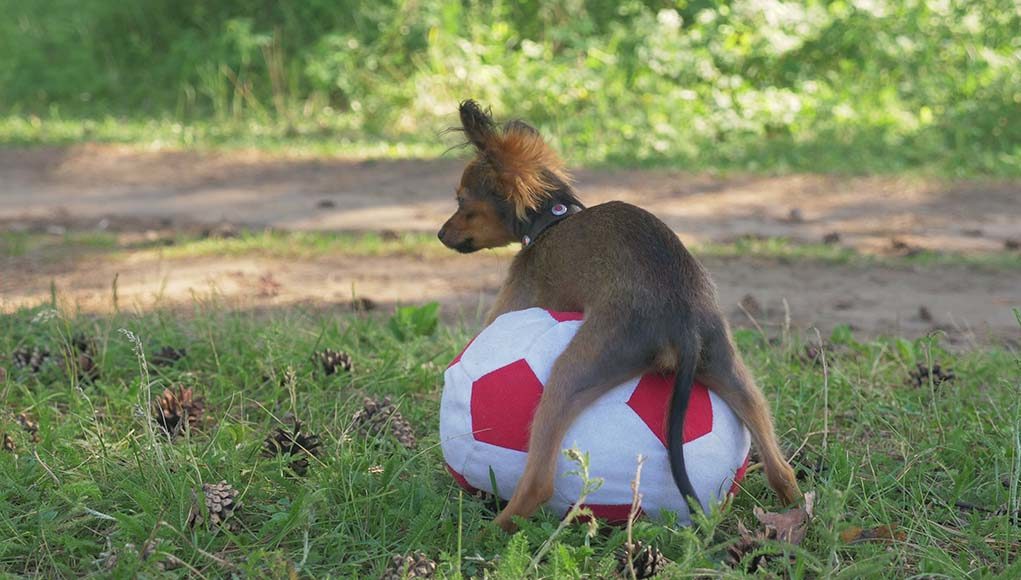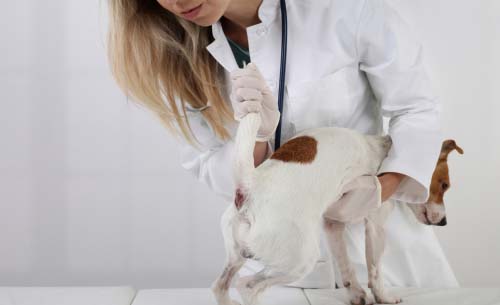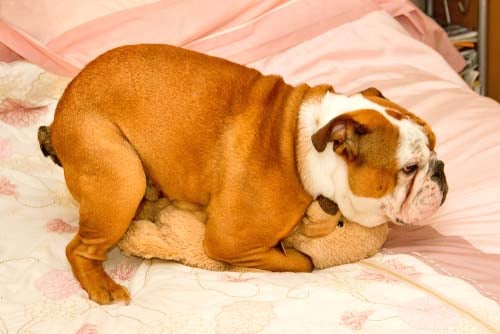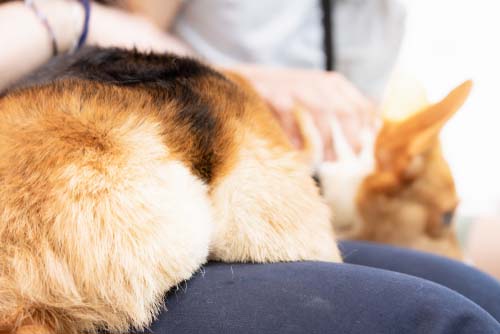Table of Contents
As a dog parent, you are going to experience more than a few situations that leave you blushing.
Some of these are over no sooner than they have begun, like the time your dog “pantsed” a total stranger at the dog park – a situation familiar to all dog owners.
But there will also be other incidents too, like the discharge from your dog’s most intimate place, and they will require you to overcome your embarrassment, acknowledge that it’s nothing that your vet hasn’t seen before and provide your dog with the care that they need.
Today we’re talking about health conditions that require you to do just that.
1. Balanoposthitis
Balanoposthitis refers to the inflammation of the dog's penis or prepuce (think foreskin).
Like vaginitis in females, balanoposthitis can occur in males of various species, including humans.
Symptoms of Balanoposthitis in Dogs
Symptoms that may indicate that your dog is suffering from balanoposthitis include:
- Increased frequency of urination
- Penile discharge (preputial discharge; this could be green, white, or bloody)
- Licking the penile area repeatedly
- Swelling and redness of the penis or penile area
- Rubbing of the area due to itch or discomfort
- Ulceration
Causes of Balanoposthitis in Dogs
Various factors can cause balanoposthitis in dogs, and these include:
- Bacterial infection
- Viral infection
- Tumors
- Fungal infection
- Foreign body presence
- Chemical agitation
- Trauma to the penis or the penile area
Like vaginitis, it is not uncommon for pet owners not to know how their dog developed balanoposthitis and only to suspect a cause after diagnosis from a veterinarian.
Getting a Diagnosis
If you suspect that your dog is suffering from balanoposthitis, head to your veterinarian right away to reduce the discomfort that your dog will certainly experience from this condition.
The vet will examine the dog's penile area for discharge and any signs of trauma.
They may then take a sample of any discharge to get a better idea of what is causing the irritation or discharge.
This helps to target treatment for better effectiveness.
Treatment
In very mild cases of balanoposthitis in dogs, your vet may carefully clean the area and allow the condition to resolve by itself without any further treatment.
In other cases, antibiotic treatment is necessary.
Antibiotics for a dog's penis inflammation are usually prescribed to be taken orally, but in some cases, an antibiotic cream must be applied to the animal's penis and prepuce.
Your vet will show you how to do this.
You may also need to regularly wash your dog’s penis and penile area with an antiseptic wash that your vet will provide.
Canine balanoposthitis may recur in dogs in the future if the underlying cause of the initial problem is not identified.
2. Vaginitis
Vaginitis refers to the inflammation of the dog's vagina or vaginal area. Like balanoposthitis in males, female mammals of various species can experience vaginitis, including humans.
Symptoms of Vaginitis in Dogs
Symptoms that may indicate that your dog is suffering from vaginitis include:
- Increased frequency of urination
- Vaginal discharge (this could be green, white, or bloody)
- Licking the vaginal area repeatedly
- Swelling and redness of the vagina or vaginal area
- Rubbing or “scooting” the vagina on the carpet to relieve itch.
Causes of Vaginitis in Dogs
Various factors can cause vaginitis in dogs, and these include:
- Urinary tract infections
- Urinary incontinence
- Abnormal anatomy
- Bacterial infection
- Viral infection
- Tumors
- Trauma to the vagina
- Foreign body presence
- Fecal contamination
- Tumors
- Abscesses
Like balanoposthitis, is not uncommon for dog owners not to know how their dog developed vaginitis and only to suspect a cause after diagnosis from a veterinarian.
Getting a Diagnosis
If you suspect that your dog is suffering from vaginitis, head to your vet right away, because your pup will undoubtedly feel uncomfortable.
Your veterinarian will likely run a urinalysis as well as take a vaginal culture. Using information from these test results along with your account of symptoms, the vet will be able to make a diagnosis.
Treatment
Treatment for vaginitis in dogs generally depends on the underlying cause.
Most frequently, treatment includes a course of antibiotics and vaginal douche treatments.
Two to three weeks after beginning treatment, a dog's vaginitis symptoms should have resolved completely.
3. Anal Gland Impaction and Abscess
The anal glands or anal sacs are two glands located on either side of a dog’s anus.
These glands get squeezed and secrete a scented oily substance when your dog goes to the bathroom.
This substance contains pheromones that provide other dogs with identifying information about your canine (such as their sex, age, and health).
Sometimes, these glands don’t function the way that they should and the oils that are usually secreted are not secreted.
This causes an odorous buildup and your dog’s anal glands are said to be “impacted”.
A veterinary professional can manually express the anal glands to release the oily build-up and relieve the impaction, but you can also do it yourself.
If impacted anal glands are not expressed and the impaction becomes more severe, swelling can prevent the fluid buildup from being expressed.
In this case, your vet will need to surgically drain the area.
Severe anal gland impaction in the dog can also lead to an abscess or a pocket of pus and infection in the glands.
This is very painful for the animal and can even cause the glands to rupture.
This is a veterinary emergency and requires immediate surgical intervention.
Symptoms of Anal Gland Impaction in Dogs
Symptoms that may indicate that your dog is suffering from anal gland impaction include:
- An unpleasant fishy odor from your dog’s hind end
- Scooting on the carpet to relief pressure, itching, and pain
- Excessive rectal licking
- Signs of pain when using the bathroom
Symptoms of Anal Gland Abscess in Dogs
Symptoms that may indicate that your dog is suffering from an anal gland abscess include:
- Worsening of the symptoms above and leaking of blood, pus, and anal gland secretions from the rectal area.
Causes of Anal Gland Impaction in Dogs
Various factors can cause or contribute to anal gland impaction in dogs, and these include:
- Repeated soft bowel movements or diarrhea due to illness
- A poor diet
- Obesity
- Anatomical abnormalities
Causes of Anal Gland Abscess in Dogs
- Untreated anal gland impaction
Getting a Diagnosis
A diagnosis of anal gland impaction, abscess, or ruptured abscess in the dog can be made through a physical exam of your dog’s anal glands.
Treatment
Treatment for minor anal gland impaction is the manual expression of the anal glands.
This is done by gently squeezing the fluid buildup from the glands by hand.
In more severe impaction cases or cases of abscess rupture, your vet may need to surgically drain the glands and clean out the infection.
A course of antibiotics and anti-inflammatory drugs will then help with healing.
Once your dog experiences anal gland impaction, it may need to have its glands manually expressed regularly to prevent future impaction.
In cases of repeated severe impaction, the vet may recommend that the dog have their anal sacs removed completely.
4. “Humping”
“Humping” or “mounting” is a natural behavior for dogs and isn’t necessarily a sexual behavior, but it can be embarrassing for dog owners to deal with.
“Mounting” in Dogs
Mounting is a behavior that dogs carry out for several reasons, including:
- Reproduction
- An expression of excitement
- A sign of dominance
- Initiation of play
The Specifics
Mounting behavior is seen in both female and male dogs, young dogs and old dogs, and intact and spayed/neutered dogs.
In young unaltered dogs, mounting behavior may be the initiation of sexual contact.
When a dog's mounting is not sexual in nature, the circumstances of the behavior can usually tell us the cause.
For example, if your dog is excited and playing one moment and then humping another dog the next, we can assume that this is likely a show of excitement and initiation of play.
On the other hand, if your dog is usually a dominant dog or “leader of the pack” and they meet another dog with a similar disposition, we may interpret mounting as a sign of dominance.
What to Do
If your dog’s mounting behavior is of concern, the first thing you should do is to pay close attention to when your dog is mounting.
This could tell you the reason for their behavior and, at the very least, it will give you more information to provide to your vet.
Next, talk to your vet.
If your dog is mounting due to sexual drive, the vet will recommend that you get your dog spayed or neutered.
This won’t immediately remedy the situation because it will take some time for hormone levels to diminish, but it should temper your dog’s drive within a few months.
If your dog is mounting out of excitement or dominance, these are both behavioral concerns that will require focused training to overcome.
The vet will recommend that you contact a professional trainer to begin this process as soon as possible.
Do You Have to Address Mounting?
Some pet owners shrug off dog mounting behavior as both harmless and natural.
While it is a natural behavior, mounting isn’t always harmless because it can create tensions that can quickly escalate into full aggression (particularly when two dominant dogs collide).
We are responsible for teaching our dogs “manners” to avoid this escalation.
5. Gas
Like us, our dogs experience gas for several reasons. Some of these are harmless, while others may require immediate veterinary attention.
Symptoms of Gas in Dogs
Symptoms that may indicate that your dog is suffering from gas include:
- Flatulence
- Burping
- Bloating or distention of the abdomen
- Loud gurgling or rumbling in the stomach area
- Inability to get comfortable
Causes of Gas in Dogs
Various factors can cause gas in dogs, and these include:
- Improper diet
- Gulping air
- Eating too quickly
- Inflammatory bowel disease
- Sudden dietary changes
- Intestinal bacteria imbalance (often due to antibiotic use or illness)
- Parasites
- Respiratory disease
Getting a Diagnosis
If your dog is experiencing regular gas or sudden changes in their digestive patterns, your vet will begin by asking you about any changes in their diet.
Diet is the number one cause of increased gas in dogs.
Your vet may also take a fecal smear to check for parasites, do a rectal smear to check bacteria levels, and run blood and urine tests to rule out other causes for concern.
In rare cases, the vet may also perform more in-depth diagnostic tests like an ultrasound, radiograph, or intestinal biopsy.
These tests are usually performed when other treatment approaches have been unsuccessful or when symptoms indicate that there may be more going on than simply “gas”.
Treatment
Treatment for gas in dogs depends on the cause of the problem.
If your dog developed gas after a recent diet change, your vet will likely recommend returning to their old food or making a slower transition to the new food to limit digestive upset.
If your dog developed gas as a side effect of a medication, the vet may ask you to weigh the pros and cons of that medication before taking any action.
If your dog developed gas as a result of parasites, a quick course of anti-parasitic drugs and dewormers should resolve the problem.
If a bacterial imbalance in your dog’s intestines is the culprit, your vet may recommend a course of antibiotics and probiotics (not to be given at the same time) to reconstitute the “good” bacteria in your dog’s gut and put everything into its natural balance.
When something like irritable bowel is the culprit of a dog’s gas, the vet will likely recommend a medication to manage symptoms as well as a prescription diet to reduce flares.
FAQ
What are the top health issues for dogs?
The three most common health problems dog face are: gum disease, ear infection, and obesity.
Sadly gum disease and obesity, can be fatal, but are preventable with appropriate teeth cleanings and monitoring what you feed them.
It’s Not the End of the World…
Being a responsible guardian to any animal means facing up to embarrassing moments whether you want to or not.
This may bring you little comfort as you prepare for your pup’s latest “situation”, but we want you to know that you’re not the first dog owner in this position and you certainly won’t be the last.
So, take a deep breath, remember all that your dog does for you, and be the paw-rent that your dog deserves.
READ NEXT: 25 Most Serious Dog Health Symptoms That Cannot Be Ignored

















